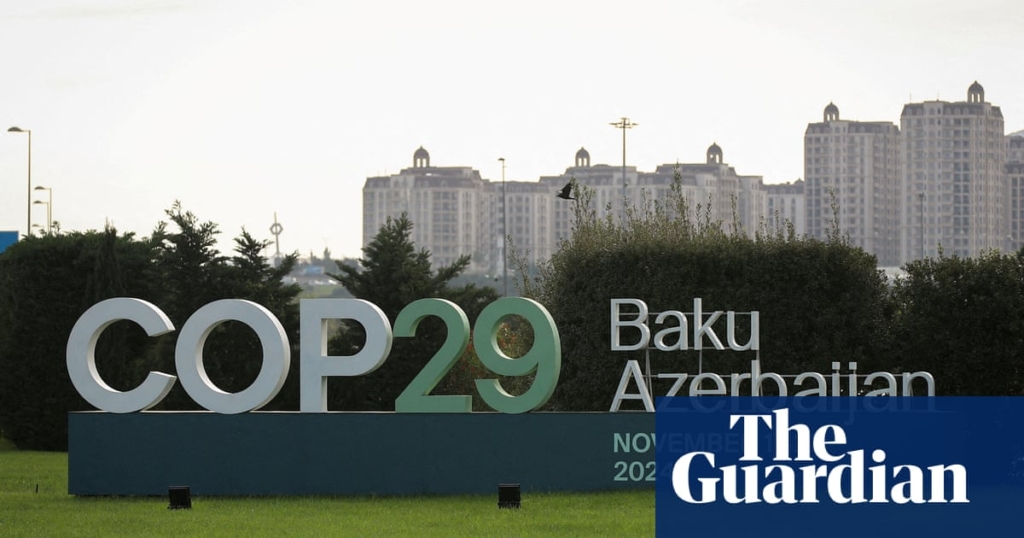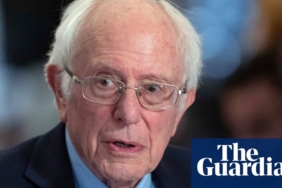İçindekiler
Bu içerik, Cop29 ve Cop30 gibi Birleşmiş Milletler iklim konferanslarında ele alınan konuları ve önemli kavramları açıklamaktadır. Cop29, Azerbaycan’ın başkenti Bakü’de gerçekleşecek ve iklim finansı, gelişmekte olan ülkelerin ihtiyaçları ve finansman kaynakları gibi konuları ele alacaktır. NCQG, iklim finansına ilişkin yeni bir kolektif hedefi temsil ederken, Cop30’da 1.5C hedefine ulaşma çabaları öne çıkacaktır. Ayrıca, metan, SLCP’ler, karbon dengeleme ve IPCC gibi kavramlar da açıklanmaktadır. Troika ve Cop30 gibi gelecekteki konferanslar da özetlenmiştir.
Kaynak: www.theguardian.com
Cop
Cop29 will be the 29th conference of the parties to the UN framework convention on climate change (UNFCCC), the parent treaty to the 2015 Paris agreement. It takes place in Baku, the capital of Azerbaijan, on the shores of the Caspian Sea, where some of the world’s first ever oil wells were dug in the mid-19th century. Azerbaijan has a claim to be the world’s first petrostate, and is still dependent on oil and gas for 90% of its export revenues.
Delegates will be expected to debate the future of climate finance. Developing countries need large injections of cash, to help them cut greenhouse gas emissions and cope with the impacts of extreme weather. Developed countries argue that their taxpayers cannot shoulder the whole burden of providing such investment, and are seeking the recruitment of new donors – major economies and big emitters such as China, Saudi Arabia, the United Arab Emirates and others – as well as potential new sources of finance.
NCQG
The core issue for discussion at Cop29 is the NCQG, the new collective quantified goal on climate finance. This refers to the requirement under the 2015 Paris climate agreement for developed countries to provide climate finance to the poor world, to help countries cut their greenhouse gases and cope with the impacts of the climate crisis.
Developing countries, excluding China, will need about $2.4tn (£1.84tn) a year in climate finance by 2030, according to a landmark study by the economists Lord Stern and Vera Songwe, in 2022. But close to half of this is likely to come from countries’ existing budgets and domestic private sector investment, with the rest – roughly a trillion – needing to come from international climate finance.
Those figures are widely accepted and form the basis of the demands of developing countries for an NCQG that delivers about $1tn to $1.4tn a year by 2035.
However, developed countries are unlikely to agree that much more than half of such sums could come from their taxpayers. That leaves a gap of several hundred billion dollars a year needing to be filled from other sources, which could include vastly expanded lending from the World Bank, International Monetary Fund and other multilateral development banks; and innovative forms of finance, including taxes on wealth, fossil fuels and high-carbon activities. Private sector investment could also play a role.
So instead of a single goal, there are likely to be at least two goals, with a narrative that explains how the gap between the two can be filled. Some parties are referring to this as a “layered” goal, with the “quantum” – the core amount that developed countries will pledge to meet by 2035 – surrounded by a variety of options that could be invoked to meet the much larger overall goal that is based on poor countries’ actual needs.
Another contentious issue is which countries should contribute to climate finance. At climate Cops, there is a stark division between the developed countries, which carry an obligation to provide climate finance, and developing countries, which do not. But since the UNFCCC – the treaty under which Cops take place – was signed in 1992, the global economy has undergone vast shifts. Many developing countries are now much richer and have much higher emissions – including China, now the biggest emitter globally, and India. Meanwhile petrostates such as Saudi Arabia, the United Arab Emirates, and Qatar, which have high per capita GDP and boast massive investments overseas, are treated as developing countries on a par with destitute and vulnerable nations such as South Sudan.
Rich countries including the US and the EU want to recognise this shift by expanding the number of contributors to climate finance. They face strong resistance, but it is possible a compromise that retained some distinction between historically developed and developing countries could be found. Some countries could end up being both potential contributors, and potential recipients.
$100bn
The only existing climate finance commitment from the rich world to the poor is the totemic £100bn pledge, which dates back more than a decade. Developing countries were promised, at the Copenhagen Cop in 2009, that they would receive at least $100bn a year in climate finance from 2020, from public and private sector sources, to help them cut greenhouse gas emissions and cope with the effects of extreme weather. That promise was not met: at Cop26, it was found that about $80bn was provided in 2019.
Data from the OECD last year found that the target had finally been achieved, but the delay left many countries with grievances and a lack of trust in the rich world. There are also severe distortions in how the money has been distributed: much of the finance has gone to mitigation efforts in middle-income countries that have relatively little difficulty in attracting private sector investment; little has gone to adaptation and resilience; some finance has been in the form of loans that add to countries’ debt piles; and Africa and the least developed countries have received far less than they need.
Developing countries will want the NCQG to avoid these pitfalls.
Loss and damage
One of the most contentious issues in climate finance has long been known as “loss and damage”. This refers to the most devastating ravages of extreme weather, so great that no amount of adaptation can help with them. Examples include hurricanes and typhoons, the devastating floods that hit Pakistan in summer 2022, or the droughts afflicting swathes of Africa.
Recovery from such devastation can take years, if it is ever achieved, and the infrastructure of developing countries, services such as health and education, and their chances of improving people’s circumstances can suffer permanent damage. The world’s poorest countries, which have done least to cause the climate crisis, are most at risk.
In the past, some experts characterised loss and damage as a form of compensation or reparations for poor countries. However, this was unacceptable to developed and large developing countries, which refused to sign legal agreements potentially leaving them liable for unlimited future costs. So the discussion moved on to loss and damage as a form of rescue and rehabilitation for the countries suffering most, addressing broader social and development issues as well as the immediate impacts of extreme weather.
Funds for loss and damage would be included in the overall NCQG, but would have their own administration system, currently being set up under the World Bank, to allow them to be disbursed quickly to countries in need.
Innovative forms of finance
Developing countries need more than $1tn a year in climate finance; developed countries are unlikely to pledge to provide much more than half that. The shortfall could be made up from “innovative finance” – new sources of cash that could be turned towards tackling the climate crisis.
Some of these are obvious – for instance, taxing fossil fuels, or carbon emissions. Some countries slapped windfall taxes on oil and gas during the bonanza for fossil fuel companies that followed Russia’s invasion of Ukraine, and even the staid and conservative International Energy Agency called for such measures.
A wealth tax on billionaires also has widespread support from activists, though many developed country treasuries are privately hesitant. Brazil has proposed a wealth tax of 2% on billionaires that it says would raise $250bn and only affect about 100 families globally.
Levies on frequent flyers could be designed to fall only on the rich, or the minority of the global population who make more than one return flight a year. Aviation accounts for about 3% of global emissions, and continues to grow. Imposing a small charge on shipping could also generate billions, could be easily collected, and is especially relevant as many ships are dirty and inefficient, and carry large quantities of fossil fuel around the world.
Another idea is to repurpose some of the hundreds of billions of subsidies that each year go to harmful agricultural practices, encourage overfishing, or benefit the fossil fuel industries. Carbon trading could also generate useful contributions towards the NCQG, though this is more contentious.
Mitigation
Within the context of the UNFCCC, mitigation always means the reduction of greenhouse gas emissions.
Adaptation (also sometimes known as resilience)
The world has already warmed by 1.1-1.3C above preindustrial levels, and some of the impacts of the current heating are irreversible, so even if we succeed in cutting emissions drastically, we will still need to adapt to the impacts of more extreme weather.
Infrastructure, including transport, telecommunications networks, housing and rural areas will need to be adapted and protected, for instance by building railways less likely to buckle in the heat or roads less likely to melt, and building houses that will not overheat.
However, climate finance for adaptation and resilience has lagged far behind that for mitigation, and in the NCQG developing countries will want to see recognition of the need for at least doubling the proportion that goes to meet their adaptation needs.
UNFCCC
The UN framework convention on climate change, signed in 1992 at the Rio Earth summit, binds all of the world’s countries – bar a handful of failed states – to “avoid dangerous climate change”. However, it did not set out in detail how to do so.
Kyoto protocol
The first attempt to turn the UNFCCC’s resolution into action was the 1997 Kyoto protocol, which set targets on emissions cuts for each developed country, stipulating a 5% cut in global greenhouse gases overall by 2012. Developing countries, including China, were allowed to increase their emissions. However, the protocol immediately ran into trouble when the US, which signed the treaty under Bill Clinton, could not ratify it owing to opposition in Congress.
The protocol eventually came into force without US backing in 2005, but by then was largely irrelevant, so countries set out on the long journey to a new treaty that would fulfil the UNFCCC aims, resulting in the 2015 Paris accord.
The Paris agreement
Forged at a historic summit in December 2015, this marked the first time developed and developing countries agreed to limit greenhouse gases in order to stay within set temperature limits. The main goal of the Paris agreement is to limit global heating to “well below” 2C above preindustrial levels, while “pursuing efforts” to stay within the lower, safer threshold of 1.5C. Countries set out targets to stay within those limits, in the form of nationally determined contributions (NDCs).
NDCs
Nationally determined contributions are national plans containing targets on emissions cuts, usually pegged to 2030, and some details on how they will be met. They form the heart of the Paris agreement. In the negotiations leading up to the Paris summit, countries were reluctant to accept “top-down” targets such as those contained in the Kyoto protocol, which set a global goal for emissions reduction then divided up the cuts needed among the developed countries. Instead, they opted for each government offering the emissions reductions it thought feasible.
However, this resulted in a set of NDCs submitted at Paris that would result in catastrophic heating of more than 3C. So the Paris agreement contains a “ratchet” mechanism by which every five years countries must return to the negotiating table with fresh commitments, to bring emissions in line with the overarching temperature targets.
At Cop26 in Glasgow, countries agreed to hasten the ratchet, asking for new pledges every year instead of just every five years. That has not really happened, however: the next round of NDCs will be expected next year, at Cop30 in Brazil.
1.5C
The Paris agreement contains two key goals, of limiting global heating to “well below” 2C, while “pursuing efforts” to limit temperature rises to 1.5C above preindustrial levels. These temperature goals have their roots in reports by the Intergovernmental Panel on Climate Change. The 2007 IPCC fourth assessment report suggested the world was likely to warm by at least 1.8C, even if measures were taken to limit emissions, and by 4C if emissions went untrammelled. Keeping warming to about 2C was regarded as the outer limit of safety, beyond which the impacts of climate breakdown – heatwaves, droughts, floods, sea-level rises, fiercer storms and other extreme weather – would become catastrophic and irreversible.
Some big emitters, including China, argued 2C was the only realistic limit and opting for a lower goal would be economically difficult. However, small island states pointed to science showing they were likely to be inundated by sea-level rises and storm surges at warming above 1.5C. The conflict was eventually resolved in the compromise of two goals at Paris. A further IPCC report in 2018 found extreme weather and severe impacts from even a 1.5C rise, so for Cop26 the UK hosts made “keeping 1.5C alive” the core aim of the conference.
Temperatures have already breached the 1.5C limit, though not for long. Most climate scientists, surveyed by the Guardian this year, believe that the 1.5C limit is already out of reach. However, many experts argue the target should be kept as the global aim, in order to try to ensure any overshoot is as small as possible.
Net zero
This basically means reducing greenhouse gas emissions as far as possible and then offsetting any remaining irreducible emissions – for instance, from industrial processes that emit CO2, or sectors such as aviation where alternative technologies are not available – by fostering carbon sinks, such as forests. The concept has come under attack from campaigners who argue that some companies and governments are using net zero as a fig leaf by assuming they can offset emissions rather than reduce them.
IPCC
The Intergovernmental Panel on Climate Change. The body of the world’s leading climate scientists, first convened by the UN and the World Meteorological Organization in 1988, has produced five comprehensive assessment reports since, each increasing in certainty and reinforcing the message that the climate crisis, caused by human actions that increase the levels of CO2 and other greenhouse gases in the atmosphere, is accelerating.
The latest IPCC report, the sixth, has been published: the first instalment, on the physical science of the changing climate, was released in August 2021, delivering the starkest warning yet of the calamity we face. It found the climate crisis was “unequivocally” the result of human actions, was putting in changes that in some cases were already “irreversible”, and that some of those changes were “unprecedented” in hundreds of thousands of years. The second and third parts, published in 2022, warned that the 1.5C goal was slipping out of reach, and that it was “now or never” for climate action.
The IPCC has been criticised for giving too conservative a view of climate science – its key findings, in the “summary for policymakers”, are subject to approval and amendment by governments before publication, which some say means they are unduly weakened.
Methane
A powerful greenhouse gas, which can trap heat in the atmosphere about 80 times more effectively than CO2. Whereas CO2 lingers in the atmosphere for about a century once released, methane degrades in a couple of decades to CO2. It comes from leaking fossil fuel infrastructure, such as oil wells and shale gas wells, and from animal husbandry and other agriculture. Many countries are hoping for progress on methane at Cop29, and particularly new commitments from China, a major emitter of the gas.
SLCPs
Short-lived climate pollutants. These are compounds such as methane, hydrofluorocarbons and soot. They degrade or fall out of the atmosphere more quickly than CO2, but while they are active can play a major role in heating the atmosphere, so actions to reduce them could buy humanity some time in cutting warming sooner. For example, moves to drastically limit methane could reduce warming by as much as 0.2C, according to some estimates. Soot stains white snow and ice, and the dark surfaces absorb more heat, in a feedback loop. Hydrofluorocarbons are substitutes for the ozone-destroying chlorofluorocarbons, but they have a high warming potential, with some capable of trapping more than 11,000 times as much heat as CO2.
Carbon offsetting
CO2 has the same impact on the climate no matter where it is emitted and what the source, so if a tonne of CO2 can be absorbed from the atmosphere in one part of the world it should cancel out a tonne of the gas emitted in another. So, in theory, companies, governments and individuals can cancel out the impact of some of their emissions by investing in projects that reduce or store carbon – forest preservation and tree planting are among them, but carbon credits are also awarded for projects that reduce fossil fuels in other ways, such as windfarms, solar cookstoves or better farming methods. The practice has been controversial.
At Cop29, countries will discuss article 6 of the Paris agreement, which allows for carbon trading among signatories, and which could be one of the sources of innovative finance under discussion for the NCQG.
UAE Consensus and paragraph 28
Cop28 in Dubai in 2023 made a historic commitment to “transition away” from fossil fuels. Though this may seem a weak formulation, and carries no deadline for its achievement, the resolution points towards the need for an eventual phase-out of fossil fuels, and was the first time that such a commitment has been made by all countries. Some governments, including Saudi Arabia and other members of the “like-minded developing countries” grouping, have since tried to unpick or row back from this commitment, and it may come under attack at Cop29.
The “transition away” wording came in paragraph 28 of the Cop28 decision (of decision 1/CMA.5, to give its full technical location), and is a key part of the “UAE Consensus”, the name given to the outcome of last year’s Cop. Other key elements to the consensus are resolutions on tripling renewable energy and doubling of energy efficiency by 2030.
Troika
One innovation for Cop29 is the formation of the “troika”, made up of the current presidency, Azerbaijan; the last presidency, UAE; and the next presidency, Brazil. The troika is supposed to provide continuity and consistency among presidencies, and help countries hosting the conference to learn from each other.
Some have whispered that relations between UAE and Azerbaijan have been strained at times, with suggestions that UAE is seeking to hog the limelight for its own ends, and that the pair may be rivals as much as partners; and though there have been periodic public announcements from the three, it is difficult to discern how much the new structure has achieved in substance. However, Brazil has taken advantage of the troika to keep hammering home its own message: that next year’s Cop30 must produce the emissions cuts needed to stave off the worst of the climate catastrophe.
Cop30
Nations will meet next November in Belém, a city near the mouth of the Amazon in Brazil, for the next iteration of the 30 years of UN climate negotiations. Brazil hosted the Rio conference in 1992 at which the UNFCCC, the UN Convention on Biodiversity and the UN Convention to Combat Desertification were signed.
At Cop30, the key task will be a new round of NDCs that measure up to the globally agreed goal of limiting temperature rises to 1.5C above preindustrial levels. It will represent humanity’s last chance of staying within that crucial threshold.





Yorumlar kapalı.